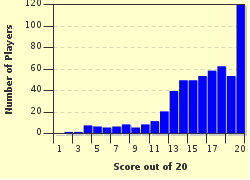Quiz Answer Key and Fun Facts
1. History shows that modern day pinball machines were based on an older game called "Bagatelle"(French). It was originally a tabletop game made of wood, and was played by using a 'cue' to shoot balls onto the playing surface. Then the balls would bounce off numerous wooden pins and come to rest in a pocket or hole that had assigned scores.
According to Webster's New World Dictionary, what english meaning is the original definition attributed to the french word "bagatelle"?
2. In 1871, a British inventor was issued a U.S. patent for what he called "Improvements to Bagatelle", with many of these 'improvements' still used in the design of pinball machines of today.
What was this inventor's name?
(no relation to actress Lynn)
3. The game was so popular in France that the French soldiers, who were helping the British in the American Revolutionary War, brought their Bagatelle tables with them. Its popularity spread quickly in America and one of the major newspapers printed an 1863 political cartoon showing the President of the U.S. happily playing Bagatelle.
Which U.S. President of 1863 had his caricature shown in the cartoon?
4. The name "pinball" was not seen until a few years after tabletop bagatelle machines began to appear in various venues. Although articles on the history of pinball vary as to which year the term "Pinball" began to be used and who was the first person to use it, they are precise about the decade when the name appeared.
In which decade did the games' manufacturers start referring to the game as "pinball"?
("Pinball" - one of the better things coming out of the "Great Depression" era.)
5. In 1931, the first 'pinball style' game to show up was a countertop mechanical game and featured many improvements that had been suggested by an inventor and fan of the game from the 1800's.
What was the name of the first 'pinball' game released for use in public venues?
(think of another very popular game that uses balls and is played in big halls by many people at the same time)
6. The first coin-operated commercially successful 'pinball machine' was called "Baffle Ball" and came out in 1931.
What is the well-known name of the amusements company that manufactured "Baffle Ball"?
(one of the few companies that were still making machines in the last decade)
7. The first 'pinball' machine, "Baffle Ball", became the first overnight hit of the coin-operated games era, with an initial manufacturing run of over 50,000 units, of which most sold out very quickly.
How much did the machine, "Baffle Ball", originally sell for?
(this amount today MIGHT get two people into a movie, but NO Popcorn!)
8. Due to the rise in illegal gambling in 1930s America, many cities and counties rushed to pass laws regulating and/or banning pinball. One major city actually banned pinball altogether in 1940, a ban that lasted until 1976!
What major eastern city had a 36 year ban on pinball machines?
(with a population of approx. 8.5 million, that would have been a lot of coins for pinball vendors in this city!)
9. On the US West Coast, Los Angeles banned pinball machines from 1939-1974. Despite these cities overturning the bans, many places refused to follow. To try and deal with what they deem to be illegal bans, the manufacturers put a specific notice on all of their more recent pinball machines in an attempt to legitimize their legal nature.
What does this notice say?
(these notices still appear on pinball machines today)
10. In Japan, they play a game which is a close and distinct relative of pinball. The game in Japan is very different though in that it involves quickly launching a lot of small steel balls, one after the other, into a vertical playing field.
What is the name of the pinball machine's 'Japanese relative'?
(sounds like everyone's favourite game on The Price is Right)
11. The game of pinball became so popular, so quickly, that by the end of 1932, there were almost 150 companies manufacturing pinball machines, yet by 1934, only 14 remained.
Which company(s) made it through the major downsizing in the 1930's of game developers and remained in the top three developers in the design and manufacture of pinball machines?
12. In 1947, a new invention came from D.Gottlieb & Company, and it appeared for the first time on a pinball machine called "Humpty Dumpty". It's hard to believe that pinball as we know it, ever existed without this important invention.
What invention am I speaking of that brought big changes in how we played pinball?
(games last a lot longer when you have this invention to keep the ball in play)
13. Typical to mankind's fashion, pinball players quickly learned that by lifting, shaking, and moving the table around would help them get higher scores and win more games. So in effect, players learned how to 'cheat' the machines.
What mechanism was quickly invented and installed on pinball tables to dissuade players from 'cheating'?
14. Another early invention installed on machines gives pinball tables their most important playability feature. These items create the electromagnetic field that induces the steel ball to move around the playing field in a sometimes quick and erratic manner.
What's the name of these items that give action to the steel game ball?
15. Pinball machines/tables have various items on their playing fields that give you points when the ball makes contact with them.
What name was given to the round knobs that when hit by the ball, usually make a 'bell sound', give the player points, and actively push the ball away?
(these can make the ball go crazy when there are three or four close together)
16. Another important game item on pinball machines appeared for the first time in 1962, and appear in sets or singular. These game enhancing inventions have various names such as; "stationary", "bullseye", "drop", "vari", and the "kicking" varieties and sometimes there are even "moving" ones.
Which of the following items am I speaking of?
(the name goes AFTER each of the varieties' names)
17. As pinball machines became increasingly complex, many idiosyncratic features began to appear on the designs of different manufacturers.
Which of the following features, once unique to a specific game maker, is now considered standard on almost 100% of all machines?
18. One of the truly exciting features of playing pinball, is the opportunity you have to win a free game! Up until the 1950s, the only way to win a free game was to acquire a score that was equal to, or higher than, a programmed points amount. Then as the manufacturers designed the games to be harder to win on, they added gameplay methods that allowed the player to win free games by accomplishing some or all of the games' objectives or even just by chance.
Which of the following player accomplishments would award a free game or games to the player who was skillful (or lucky) enough to attain the objective(s)?
19. The largest commercially produced pinball machine ever, built in 1979, was called "Hercules" and it measured 6'11" tall, 3'3" in width, and 7'11" in length, and is still known to be the largest pinball machine ever made.
What video game manufacturer built and manufactured the game of "Hercules"?
(famous for inventing and marketing "Space Invaders")
20. Here is a fun pinball fact. In 1974, Ronald L. Mowry set a world record for playing pinball non-stop for over three days, on a machine called "Super Soccer" made by "D. Gottlieb". He spent over $100 in quarters, despite winning 145 free games.
After 709 games of pinball, why did Ronald have to stop playing?
Source: Author
krazykritik
This quiz was reviewed by FunTrivia editor
Bruyere before going online.
Any errors found in FunTrivia content are routinely corrected through our feedback system.

